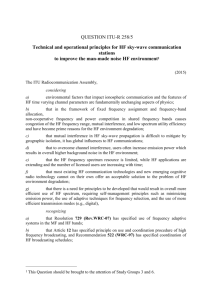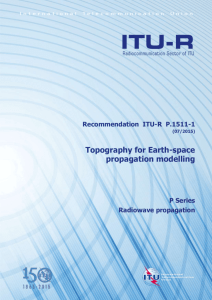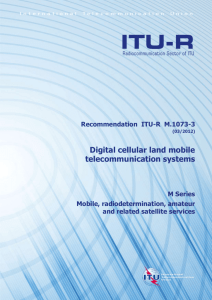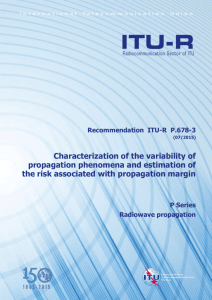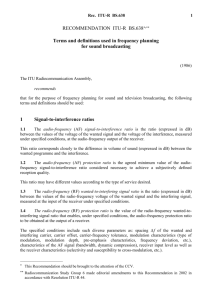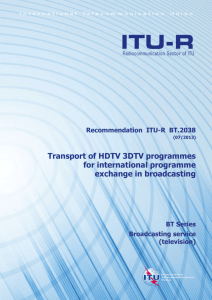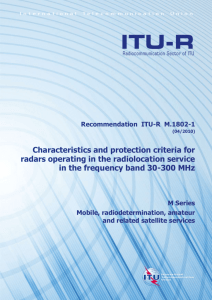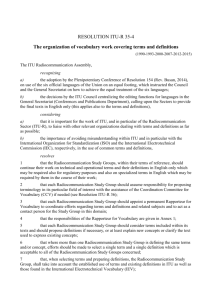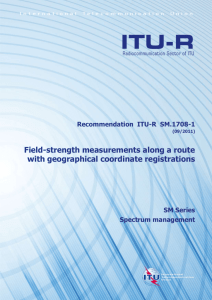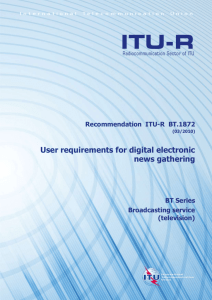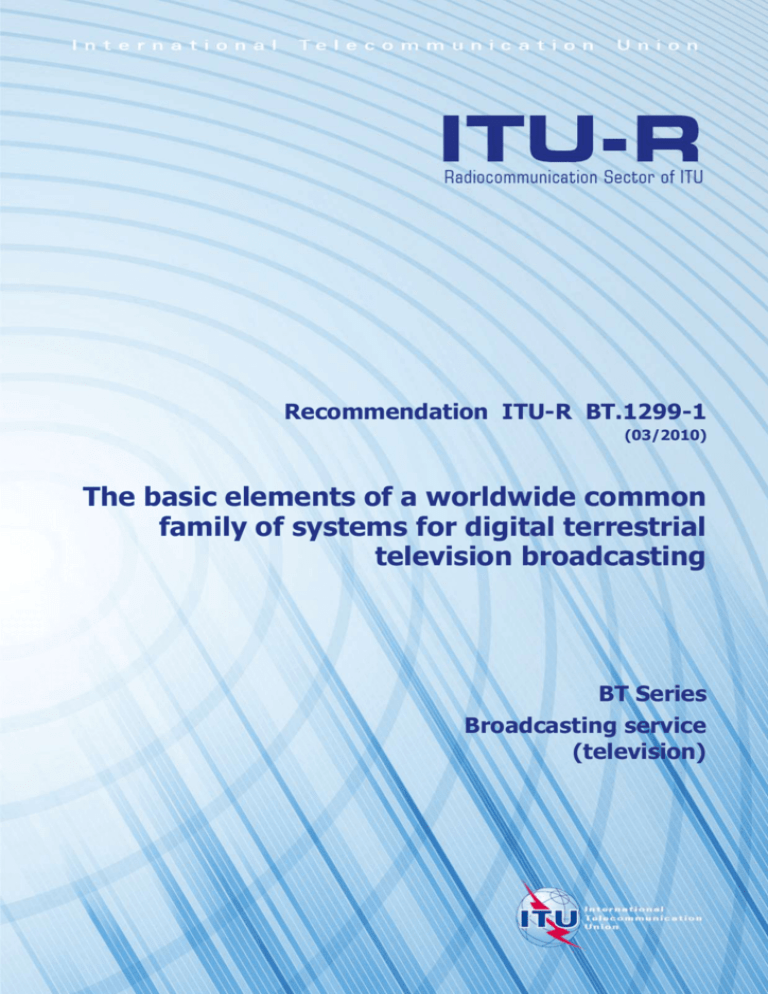
Recommendation ITU-R BT.1299-1
(03/2010)
The basic elements of a worldwide common
family of systems for digital terrestrial
television broadcasting
BT Series
Broadcasting service
(television)
ii
Rec. ITU-R BT.1299-1
Foreword
The role of the Radiocommunication Sector is to ensure the rational, equitable, efficient and economical use of the
radio-frequency spectrum by all radiocommunication services, including satellite services, and carry out studies without
limit of frequency range on the basis of which Recommendations are adopted.
The regulatory and policy functions of the Radiocommunication Sector are performed by World and Regional
Radiocommunication Conferences and Radiocommunication Assemblies supported by Study Groups.
Policy on Intellectual Property Right (IPR)
ITU-R policy on IPR is described in the Common Patent Policy for ITU-T/ITU-R/ISO/IEC referenced in Annex 1 of
Resolution ITU-R 1. Forms to be used for the submission of patent statements and licensing declarations by patent
holders are available from http://www.itu.int/ITU-R/go/patents/en where the Guidelines for Implementation of the
Common Patent Policy for ITU-T/ITU-R/ISO/IEC and the ITU-R patent information database can also be found.
Series of ITU-R Recommendations
(Also available online at http://www.itu.int/publ/R-REC/en)
Series
BO
BR
BS
BT
F
M
P
RA
RS
S
SA
SF
SM
SNG
TF
V
Title
Satellite delivery
Recording for production, archival and play-out; film for television
Broadcasting service (sound)
Broadcasting service (television)
Fixed service
Mobile, radiodetermination, amateur and related satellite services
Radiowave propagation
Radio astronomy
Remote sensing systems
Fixed-satellite service
Space applications and meteorology
Frequency sharing and coordination between fixed-satellite and fixed service systems
Spectrum management
Satellite news gathering
Time signals and frequency standards emissions
Vocabulary and related subjects
Note: This ITU-R Recommendation was approved in English under the procedure detailed in Resolution ITU-R 1.
Electronic Publication
Geneva, 2010
ITU 2010
All rights reserved. No part of this publication may be reproduced, by any means whatsoever, without written permission of ITU.
Rec. ITU-R BT.1299-1
1
RECOMMENDATION ITU-R BT.1299-1*
The basic elements of a worldwide common family of systems
for digital terrestrial television broadcasting**
(1997-2010)
Scope
This Recommendation describes principles of the common elements, including baseband source coding,
multiplexing, and modulation and channel coding, for digital terrestrial television broadcasting systems.
The ITU Radiocommunication Assembly,
considering
a)
the many benefits of common television broadcasting standards;
b)
that ITU-R has produced a series of Recommendations on video and audio source coding,
data coding, multiplexing, and modulation and channel coding for digital terrestrial television
broadcasting;
c)
that transition from analogue to digital terrestrial television continues to be implemented
around the world;
d)
that differing regulatory, marketing, and delivery environments exist in different parts of
the world and that these and other factors will influence the choice of systems,
recommends
that the elements of a worldwide common family of systems for digital terrestrial television
broadcasting should be based on the following:
1
Systems principles
1.1
The terrestrial system should have maximum commonality with other digital television
delivery systems, such as satellite, cable, etc.
1.2
The broadcast systems should be designed as a “container”, able to transport video and
audio, and/or other data services, in a transparent and flexible way (see Recommendations ITU-R
BT.1207 and ITU-R BT.1209).
*
Radiocommunication Study Group 6 made editorial amendments to this Recommendation in 2002 in
accordance with Resolution ITU-R 44.
**
This Recommendation should be brought to the attention of Telecommunication Standardization Study
Group 9.
2
Rec. ITU-R BT.1299-1
1.3
The systems should permit statistical multiplexing1.
1.4
The base system should be a single layer system capable of conveying, for example, one
HDTV service or a number of SDTV quality services. The number of services per channel will
depend on the available total data rate, quality required, programme content and on whether
statistical multiplexing is used.
1.5
A service information and header descriptor system should be implemented
(see Recommendation ITU-R BT.1300).
2
Baseband coding principles
2.1
The image coding system should be as given in Recommendation ITU-R BT.1870
(see following Note 1).
NOTE 1 – Recommendation ITU-R BT.1870 recommends use of the ITU-T Recommendation
H.262 (ISO/IEC 13818-2 (MPEG-2 Video)) and ITU-T Recommendation H.264 (ISO/IEC
14496-10 (MPEG-4 AVC)).
2.2
The sound coding system should be as given in Recommendation ITU-R BS.1196
(see following Note 1).
NOTE 1 – Recommendation ITU-R BS. 1196 recommends use of ISO/IEC 11172-3 (MPEG-1
Audio) Layer II, ISO/IEC 13818-7 (MPEG-2 AAC) LC or LC with SBR, ISO/IEC 14496-3
(MPEG-4 Audio) AAC-LC, HE-AAC or HE-AACv2, or ETSI TS 102 366 (AC 3 or E-AC-3) for
digital television broadcasting emission.
2.3
The quality requirements for the video and audio coding system performance given in
Recommendations ITU-R BT.1122 and ITU-R BS.1548 should be duly taken into account
(see following Note 1).
NOTE 1 – The basic audio and video coding specifications are of syntax only, and leave room for
improvement in quality due to improvements in encoder design.
3
Modulation and channel coding principles
3.1
The modulation and channel coding should be selected to allow implementation of the
required delivery approach. Possible delivery approaches include single-transmitter-per-channel
(as in conventional analogue TV), on-channel repeaters (OCR), gap-fillers (GF), single frequency
networks (SFN) at the local and regional levels. Orthogonal frequency division multiplexing
(OFDM) or 8-VSB (vestigial sideband) should be used depending, among other things, on the
delivery environment (see Recommendation ITU-R BT.1306).
1
Statistical multiplexing is a technique used for multi-programme transmission in a single channel to
improve the overall programme quality or to effectively use the available channel capacity by dynamically
allocating the bit-rate to each programme that shares a given channel capacity.


